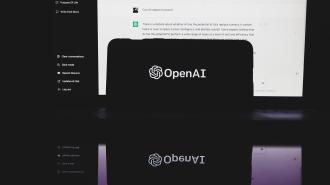Mere months after making one big splash — and spooking Google — with ChatGPT and the new Bing, the AI firm OpenAI has released the newest, best version of their generative language model yet.
As Freethink previously reported, GPT-4’s most dramatic and obvious upgrade is its ability to see — the model can use both text and images as prompts. It could “identify the artist behind a painting, explain the meaning of a meme, or generate captions for photographs.”
OpenAI also says that GPT-4 has improved its performance when it answers prompts. The version that powered ChatGPT, GPT-3.5, sometimes suffers from “hallucinations” in its results, generating text that certainly seems correct but in reality could be full of factual errors (think of it like that one guy in philosophy 101 who answers every question confidently, whether he grasps it or not).
GPT-4 is still not perfect — as even its developers will tell you — but it does outperform its prior version in accuracy and responding only to prompts that fit within its guardrails, which have been strengthened. (In one striking example test, it was not able to identify and then order potentially dangerous chemical compounds on its own.)
You can try it out for yourself by subscribing to OpenAI’s ChatGTP Plus service (but you’ll probably end up on the waitlist), but you can still use GPT-3.5 in the free version of the chatbot.
Since its official debut yesterday, the AI has already been put to work in all manner of creative applications. New stuff is coming at a furious pace, popping up across tech and AI Twitter.
To give you an idea of just what GPT-4 can do, we’ve collected some of the most interesting ones below, with some help from the Twitter feeds of AI journalists Linus Ekenstam and Rowan Cheung. What can be done in just a few hours ranges from the goofy to the amazing, to the unprecedented and simply magical.
From napkin to website
I’m sure it’s happened to you, right? Wham, thunderbolt, you get the million dollar idea. You scratch it out on the nearest available surface — say, a napkin at the bar — and then… never develop it beyond that initial a-ha.
GPT-4 may be the partner you need to turn a back-of-the-napkin sketch into reality — literally. From a simple sketch of a page on a napkin, GPT-4 was able to create an entire website, no coding necessary.
Making a video game
Okay, so the games in question, while stone-cold classics, aren’t exactly the most complex modern games. But creating Pong, Snake, and Connect 4 within minutes, and with no prior training, may just well herald a world where gamers everywhere can create their own online games with a speed and simplicity that simply has never existed before.
Working with language
Popular language-learning app (and incessant notification machine) Duolingo has begun using GPT-4’s formidable language generation skills to enhance its learning experience.
The AI powers two new features: a conversation partner called “Role Play” and “Explain My Answer,” which breaks down what you got wrong when you made a mistake.
Meanwhile, the nation of Iceland is turning to GPT-4 not to teach a language, but to save one, by initiating a program to preserve the Icelandic language, a tongue close to its Old Norse roots but at risk of being lost in the modern era.
Enhancing accessibility
Danish startup Be My Eyes has been developing tools for the millions of people with visual impairment for over a decade now. But their newest effort uses GPT-4’s new image recognition ability to create a Virtual Volunteer in the Be My Eyes app, which is able to “see” and identify things automatically. It only can tell people what is in front of them, but provide context as well. Point at your clothes, for example, and it can tell you in detail what it is looking at; point it at a menu, and it can identify both the photos of food and the text, essentially reading the menu for you.
Finding love
Digital matchmaker Keeper is using GPT-4 to scan profile data and preferences, figure out if they seem to be a good match for you, and then automates getting back to them.
It also works as a filter for, well, just about anything on the profiles, helping to ensure you get the matches you, theoretically, want. (Assuming, of course, you know what you want. But that’s perhaps a bit beyond AI’s current abilities.)
Parsing information
Ever look something up on Wikipedia only to get stuck on a pleasingly thorough — but intimidatingly complex — article?
Tome, an “AI-powered storytelling format,” is using GPT-4 to not only scan entire Wikipedia articles but to also understand them, providing you with a clear summary containing only the key points.
Bing
Bing rolled out their generative AI search engine a few months ago, and has now upgraded the chatbot with GPT-4. The improved response performance of GPT-4 should help ensure more accurate response to searches, and less freaking out over its reputation in the media.
We’d love to hear from you! If you have a comment about this article or if you have a tip for a future Freethink story, please email us at [email protected].






